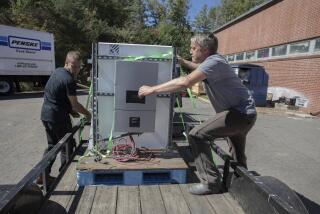Vermont stunned by flooding from Tropical Storm Irene
Reporting from Brattleboro, Vt., and New York — Rippling creeks became deluges. Bridges collapsed into roiling waves. Streets turned into fast-rising lakes, closing in around stunned towns that never knew they might be in the path of a tropical storm expected to drench the coast, not the countryside.
But while Irene unleashed its initial damage as a hurricane along the sandy shores of the Eastern Seaboard, by Monday its greatest impact was felt far from the coastline, in places like landlocked Vermont and the bucolic mountains of upstate New York.
“It was a raging torrent,” Scott Towle of Brattleboro, Vt., said of the normally benign Whetstone Brook, which runs near his house and rose with terrifying speed Sunday when as much as 8 inches of rain fell in six hours.
“You could hear boulders, trees, everything going down,” said Towle, who on Monday joined other locals at a bridge downtown watching the swollen Connecticut River rush past. “It took out the road; it took out a couple of houses; it took out a bridge.”
“It was roaring,” said Richard Hodgdon, whose backyard turned into a lake as the Whetstone Brook filled up. “It came past the house on both sides. It was flowing right down [the street]. … When we saw how fast it was rising, we had never seen that before.”
Hodgdon, his wife and their dog got out as the water filled their garage and their basement. The heavy furniture on their patio floated away to a neighbor’s driveway, next to a red barn that seemed to be on the verge of collapse Monday. A nearby footbridge that weighs more than a ton was lifted “like a toothpick” and carried downstream, said Hodgdon, who looked out at his lawn — now a sheet of mud.
“It’s hard to believe. It’s so peaceful today,” he said as the sun shined on the sludge-covered scene.
On the sixth anniversary of Hurricane Katrina’s landfall in Louisiana, the chief of the Federal Emergency Management Agency, Craig Fugate, said officials had learned from the aftermath of that storm.
“We can’t wait to know how bad it is before we get ready,” Fugate said, noting that the evacuation orders and emergency teams’ preparations for Hurricane Irene contrasted dramatically with the after-the-fact scramble that marked FEMA’s Katrina response.
More than 48 hours after Irene made landfall early Saturday, about 4.5 million people remained without power in Washington and 13 states from North Carolina to Maine. The death toll was at least 40, the Associated Press reported, and some rivers had yet to crest, meaning flooding might not be over.
Hundreds remained stranded in communities cut off by washed-out roads, including at least 2,500 residents of remote Hatteras Island in North Carolina, where severed utility lines also left them without power. The only access to the island was a ferry limited to emergency use.
Police in suburban Parsippany, N.J., had to rescue dozens of people who became trapped in two hotels Monday when a nearby lake sent enough water into the streets and hotel parking lots to swallow vehicles. Evacuees included guests who had fled to the hotels after heeding advice to leave their homes because of Irene.
There were some signs of a return to normalcy. In New Jersey, Atlantic City’s casinos reopened. New York City’s subways churned into action in time for the morning commute after an unprecedented preemptive shutdown at noon Saturday. Buses returned to service, as did some commuter railroads, and the bell clanged at 9:30 a.m. to mark the opening of trading at the New York Stock Exchange.
For millions of people, though, normalcy was nowhere to be seen.
“We were expecting heavy rains,” said Bobbi-Jean Jeun of Clarksville, a hamlet near Albany, in upstate New York, the Associated Press reported. “We were expecting flooding. We weren’t expecting devastation. It looks like somebody set a bomb off.”
In a sense, Mother Nature did.
Christopher Vaccaro, a spokesman for the National Weather Service, said the rain from Irene’s wide bands were “too much, too soon.”
“You’re having a tremendous amount of runoff, and that’s all flowing into rivers. The rivers burst through their banks and flow into roads and properties,” he said.
Compounding the problem was that soil wet from recent rain couldn’t absorb Irene’s downpour. Once the soil had reached its saturation point, there wasn’t much that could be done to prevent floods, said Kristen Corbosiero, a professor of tropical meteorology at the University at Albany.
“It’s just about getting people out of the way and trying to minimize damage as much as possible,” she said.
No one warned Valerie Becker, though. Becker, who lives beside the same Brattleboro brook that flooded Hodgdon’s home, looked out her second-story window about 10:30 a.m. Sunday and saw logs and her grandchildren’s toys floating across her lawn. She rushed around her house grabbing bedding and valuables.
“I started freaking when I came down the stairs and there was an inch of water and the driveway was completely flooded,” she said. “Then I started to get scared.”
Becker got out safely before water a foot deep poured through her home. Looking at a wet brown couch sinking in the mud on her lawn, she said: “It’s all just stuff. We all are safe. That’s what matters.” But Becker admitted she was overwhelmed. She had spread the pages of her son’s baby book on a table to dry in the sun. A box containing her youngest son’s school papers and drawings was destroyed, along with one that held her own school pictures and diplomas.
“All that stuff — gone,” she said.
David Paquette said that when he and his brother Steven bought their auto body shop in Marlboro, Vt., they knew there was a potential for flooding, but they never expected something of this magnitude. The water ripped the building in two, carrying away the brothers’ truck.
“This was just too much, too fast,” Paquette said as he salvaged what he could. “Boom. Gone. In a heartbeat.”
Reston reported from Brattleboro and Susman from New York. Times staff writers Melanie Mason in Los Angeles, Richard Simon and Michael Memoli in Washington, and David Zucchino in Nags Head, N.C., contributed to this report.
More to Read
Sign up for Essential California
The most important California stories and recommendations in your inbox every morning.
You may occasionally receive promotional content from the Los Angeles Times.












